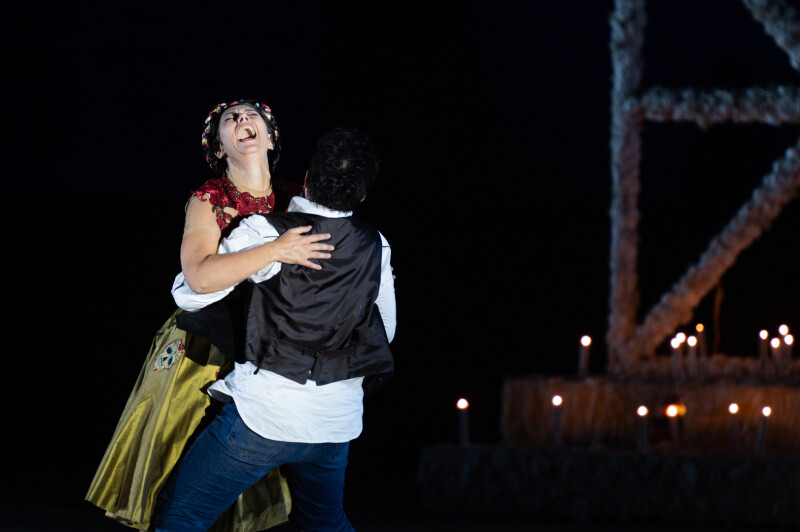

For Carrasco, her interpretation of the free spirit is a woman who has many facets and nuances. In this production, she is an abused factory worker, a pole dancer, and then a smuggler. But even though she moves in numerous circles, her freedom is bound by her fate and the director shows us this through an apparition in the production. No matter how much she tries to escape, she is tied to her fate. This apparition in the form of a little girl comes on stage every moment that Carmen’s theme of fate comes in. We see the girl during her Act three card scene, Don Jose’s aria and in the Act one prologue, among other times. This is one of the most visually striking moments in Carrasco’s production and it is also perhaps the most enlightening.
Veronica Simeoni took on the title role of Carmen, reprising the production she originated in 2017. Simeoni displayed fierce physicality in the part, pole dancing, and even dancing with a toy snake as well as rolling around in the habanera and washing up in the seguidilla. In Act three she was defiant and threw herself to the ground. Act four also saw that defiance as she threw Jose’s ring with coolness and opened up her arms to accept her death.
However, her Carmen did have moments of vulnerability as she sang the card aria in Act three. One could visibly see Simeoni’s visage turn to hesitation and fear. In the Act four duet, she did seem fearful of Jose as she was thrown to the floor and struggled to escape Jose.
But not all of Simeoni’s interpretation worked. Sometimes the mezzo was too restrained, especially in the Habanera and Seguildilla which seemed very cool and reserved, while Act four saw the mezzo walking too much around the set taking away from the drama that was unfolding.
Vocally, the Italian mezzo does not have the plush or round sound that most expect from a Carmen. It’s a lighter lyric sound with some edge in the lower notes and in the higher range. However, Simeoni knows how to use the voice to great effect. She sang with a smooth legato line in the Habanera and Seguildilla and in “Les Tringles des sistres tintaient,” she emphasized the sensuality of her voice. Her “Tra la la la” were varied with silky tone and precise runs. She also built the piece from an unusually slow tempo to a quick and energetic one that emphasized Carmen’s free spirit.
In the quintet, Simeoni showcased her virtuosity in her patter-like phrases and her playfulness in the B section as she used a breathy sound as well as a sensual timbre to persuade her colleagues. Her Act two duet with Don Jose was a bit reserved but in Act three and four Simeoni really shined. In these last two acts, the mezzo seemed most free letting out a gritty and darker sound. Her “En vain, pour éviter les réponses amères” showed Simeoni bring out her chiaroscuro low notes that while not the most resonant, cut through with big impact. Her phrases gained some weight and volume as she climaxed to the end of the piece. Gone were the lush smooth lyric sounds from the first two acts and in place were the dramatic overtones that Simeoni was capable of.
In Act four, she sang with conviction as she decided on more spoken phrases that emphasized the text. Some of her higher notes, while a bit wobbly, were effective given the dramatic moment; when she was forced to bring out her full tone, Simeoni did so with a hard-edged tone. It was by far her biggest moment of the evening and she didn’t disappoint.
Jul 24, 2022
Francisco Salazar – operawire